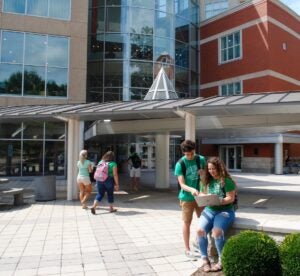Marshall University Information Technology (MUIT) is dedicated to delivering secure, high-speed WiFi services to our students, faculty, staff, and university guests. Our mission is to ensure a highly secure and reliable network that supports university business, enhances student learning and discovery, and provides residence hall occupants with an in-home experience for their entertainment devices.
MUIT is dedicated to continually modernizing our university’s network. This means we’re making improvements to different parts of our network to ensure it runs smoothly and efficiently. We’ve increased the bandwidth to the campus, strengthened the core network connections, and upgraded the links that connect our wireless systems and buildings.
Which WiFi Network should I be using on campus?
MU WiFi is the preferred network for students, faculty, and staff. It is our fastest and most secure network utilizing the 6Ghz band with WPA3 encryption.
MU_Guest is a network intended to serve guests of the university. Parents, vendors and other guests can utilize this network during their campus visit. This is a completely open, non-secure network.
eduroam is a common network among higher education institutions. Although it is a network intended for visitors from other universities, it can also be used Marshall University students, faculty and staff. This network is currently protected by WPA2 encryption which doesn’t connect to the 6Ghz network. Members of the eduroam network can visit other participating institutions and can connect to WiFi with the same credentials that you use at your home institution. See where you can get WiFi access with your Marshall username and password here.
Which WiFi Network should I be using in on-campus residences?
MU HRL is the network that uses the same infrastructure as MU WiFi but is an offering specific to our HRL residents. This network allows devices that do not authenticate with a username and password the ability to join the network. MU HRL creates a User Defined Network (UDN) in your residence hall and is private to you and/or your roommate (if applicable). This network is the connection point for Game Consoles, TVs, Roku’s, and other smart devices and gives users the ability to connect devices of visiting guests. Set up your private residence network using these instructions or by clicking the device based instructions below:
- iPhone
- Android
- Windows 10/11
- macOS
- AppleTV
- Linux
- All other devices in HRL Spaces
- All other devices in academic and administrative spaces
Troubleshooting your WiFi Connections
If you are having any issues with WiFi or having device issues in general, it is recommended that you FIRST check with the manufacturer of your device to update the system BIOS and device drivers to their recommended versions. Doing these updates ensures that your device is running at its optimal performance. Click below for current device drivers based on your device manufacturer.
Other Troubleshooting Tips & Tricks
- Make sure your devices’ drivers are up to date
- Ensure your device isn’t in Airplane Mode
- Forget ALL MU Networks: MU_Guest, eduroam and MU WiFi and REBOOT your device
- Rejoin your device to MU WiFi using your full email address (user@marshall.edu) and password
- If you are still having issues, please chat with the service desk! You can also give them a call at 304-696-3200.
For Additional Information and Help
- Submit a Ticket: MyMU – Contact Support
- Stop By the MUIT Service Desk!– Drinko Library 141
- Give us a call! 304-696-3200
- Live Chat – any MUIT webpage
